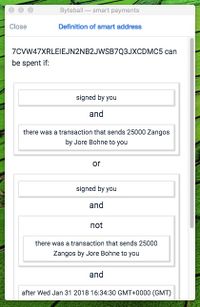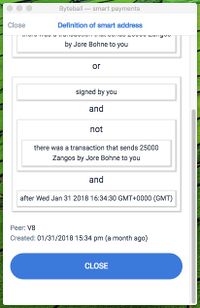Difference between revisions of "Smart contract"
m (added wikilink) |
(fchanged img upright x2) |
||
| Line 1: | Line 1: | ||
| − | [[File:smart-address-1.jpg|thumb]][[File:smart-address-2.jpg|thumb]]About smart contracts, the basis of conditional payments ("smart payments"), Byteball's killer feature. And "the competition". Not too technical | + | [[File:smart-address-1.jpg|thumb|upright=0.65]][[File:smart-address-2.jpg|thumb|upright=0.65]]About smart contracts, the basis of conditional payments ("smart payments"), Byteball's killer feature. And "the competition". Not too technical |
==Contracts. Ethereum, right?== | ==Contracts. Ethereum, right?== | ||
Revision as of 20:29, 13 March 2018
About smart contracts, the basis of conditional payments ("smart payments"), Byteball's killer feature. And "the competition". Not too technical
Contents
Contracts. Ethereum, right?
Byteball does simple, human-readable contracts to perform simple actions.
Ethereum does complex, programmer-readable contracts to perform complex actions.
No overlap.
But Rootstock?
Rootstock is a centralized smart-contract platform planned to be layered on top of Bitcoin. RSK is just released on Bitcoin testnet.[1]
One post: RSK is EVM on BTC (that is, Ethereum Virtual Machine infrastructure, but linked to and secured by bitcoin's blockchain instead, using sidechains.)
RSK is now supported on Trezor.[2]
Offering smart contracts
When you want to create a new smart contract with a user, your sequence is usually as follows:[3]
- You ask the user to send his payment address (it will be included in the contract)
- You define a new contract using the user's address and your address as parties of the contract
- You pay your share to the contract
- At the same time, you send a specially formatted payment request (different from the payment request above) to the user to request his share. You start waiting for the user's payment
- The user views the contract definition in his wallet and agrees to pay
- You receive the payment notification and wait for it to get confirmed
- After the payment is confirmed, the contract is fully funded.
See wiki Oracle article for examples and videos.
External links
References
- ↑ https://www.reddit.com/r/Bitcoin/comments/6e7mdz/rsk_testnet_is_open/?st=j3bxt1g7&sh=63cbb552 Reddit thread 2017-05-30
- ↑ http://gk2.sk/how-to-use-trezor-with-rootstock-rsk-using-myetherwallet Online article 2017-05-30
- ↑ https://github.com/byteball/byteballcore/wiki/Writing-chatbots-for-Byteball Github: Writing chatbots for Byteball

